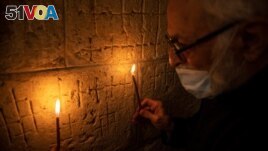10 April 2021
Israeli researchers say technology may have solved a mystery about markings at one of Christianity's holiest places.
The markings are thousands of crosses carved into the walls of Jerusalem's Church of the Holy Sepulchre. The building is one of the world's oldest Christian religious centers. It was long thought that the markings were graffiti created by religious travelers, called pilgrims, who visited the church in the past.

Father Samuel Aghoyan, the Armenian superior at the Church of the Holy Sepulchre, holds candles to illuminate crosses etched into the ancient stone wall of the Saint Helena chapel inside the church. (REUTERS/Ronen Zvulun)
But imaging technology completed during a renovation project suggests that the markings were likely part of a more organized effort. Researchers used three-dimensional (3D) imaging technology in an effort to find out how old the markings are. The researchers say the process showed that the crosses likely date back to the 15th century.
Amit Re'em is an archaeologist working with Israel's Antiquities Authority. He told Reuters that examinations of the images showed the depths and details of the markings were very similar, suggesting that only a few people had carved the crosses.
"Maybe two or three hand artists made these crosses," Re'em said. He added: "So it's not graffiti, it's something more organized."
Re'em suggested that pilgrims visiting the Jerusalem church probably paid artists to create the crosses in their name. "You pay something to this special artist and he carved for you, for the benefit of your soul and your relatives' souls," he said.
The markings represented special crosses "in the most sacred place for Christianity on Earth," Re'em added. More research is to be carried out on the markings in an effort to confirm the latest findings.
Father Samuel Aghoyan is an Armenian official at the Church of the Holy Sepulchre. He told Reuters he thinks the new research can help the church, especially as it struggles with COVID-19 restrictions.
"Now there are no pilgrims here, (but) still their spirit is here, we know, I believe in that," he said.
I'm Bryan Lynn.
Tommy Walker reported this story for VOA News. Bryan Lynn adapted the report for Learning English, with additional information from The Associated Press. Mario Ritter, Jr. was the editor.
We want to hear from you. Write to us in the Comments section, and visit 51VOA.COM.
______________________________________________
Words in This Story
carve – v. to make an object, shape or pattern by cutting wood, stone, etc.
graffiti – n. pictures or words painted or drawn on a wall, building or something else
imaging –n. the process of creating and showing pictures on a computer
renovate – v. to repair and decorate an old building
three-dimensional (3D) – adj. having or appearing to have length, depth and height
antiquities – n. items from the ancient past
benefit – n. a helpful or good effect
soul – n. the part of a person that is not their body, which some people believe continues to exist after they die
sacred – adj. relating to religion or considered to be holy